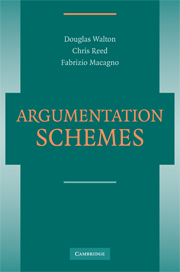Book contents
- Frontmatter
- Contents
- Acknowledgments
- Introduction
- 1 Basic Tools in the State of the Art
- 2 Schemes for Argument from Analogy, Classification, and Precedent
- 3 Knowledge-Related, Practical, and Other Schemes
- 4 Arguments from Generally Accepted Opinions, Commitment, and Character
- 5 Causal Argumentation Schemes
- 6 Schemes and Enthymemes
- 7 Attack, Rebuttal, and Refutation
- 8 The History of Schemes
- 9 A User's Compendium of Schemes
- 10 Refining the Classification of Schemes
- 11 Formalizing Schemes
- 12 Schemes in Computer Systems
- Bibliography
- Index
- References
6 - Schemes and Enthymemes
Published online by Cambridge University Press: 05 June 2012
- Frontmatter
- Contents
- Acknowledgments
- Introduction
- 1 Basic Tools in the State of the Art
- 2 Schemes for Argument from Analogy, Classification, and Precedent
- 3 Knowledge-Related, Practical, and Other Schemes
- 4 Arguments from Generally Accepted Opinions, Commitment, and Character
- 5 Causal Argumentation Schemes
- 6 Schemes and Enthymemes
- 7 Attack, Rebuttal, and Refutation
- 8 The History of Schemes
- 9 A User's Compendium of Schemes
- 10 Refining the Classification of Schemes
- 11 Formalizing Schemes
- 12 Schemes in Computer Systems
- Bibliography
- Index
- References
Summary
One of the most valuable uses of schemes is to enable an argument analyst to fill in implicit assumptions needed to make sense of a given argument she is trying to analyze. Arguments that have missing (unstated) premises or conclusions are traditionally called enthymemes in logic. One problem with enthymemes is that reasonable people can have differences of opinion on what the implicit assumptions are supposed to be. Filling in the missing parts of an enthymeme may depend on interpreting the natural language text in which the argument was put forward, to try to fairly judge what the speaker meant to say. The danger of attributing such missing assumptions to an arguer is that of unwittingly committing the straw man fallacy. This fallacy is committed when an arguer misrepresents her opponent's position to make it look more extreme or unreasonable than it really is, in order to attack it more easily. In some cases, more than one interpretation of a given argument is possible. Thus the problem is to find out what kind of evidence is needed to support or question the claim that some proposition really can be inserted into an apparently incomplete argument presented in a text of discourse, without unfairly distorting what the speaker meant to say. It will be shown in this chapter, by studying key examples, how argumentation schemes constitute an important part of this evidence.
The goal of this chapter generally is to explore the role of argumentation schemes in enthymeme reconstruction.
- Type
- Chapter
- Information
- Argumentation Schemes , pp. 189 - 219Publisher: Cambridge University PressPrint publication year: 2008
References
- 1
- Cited by



